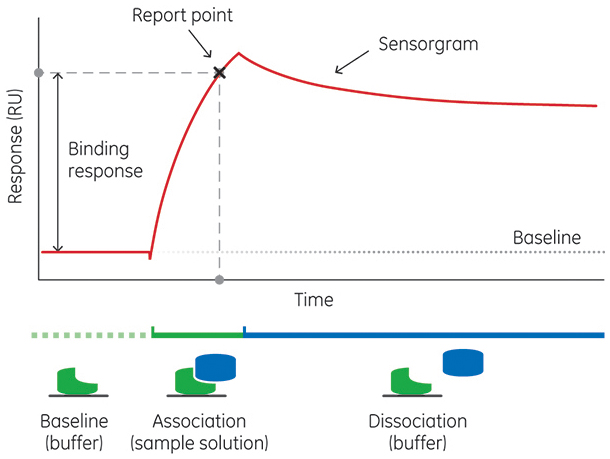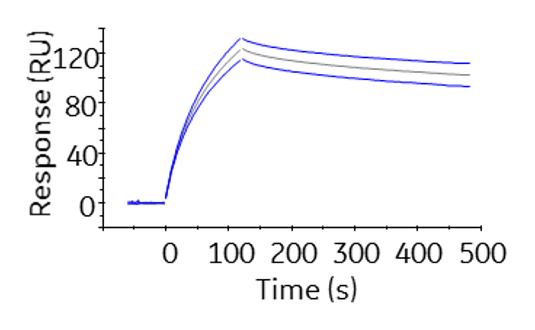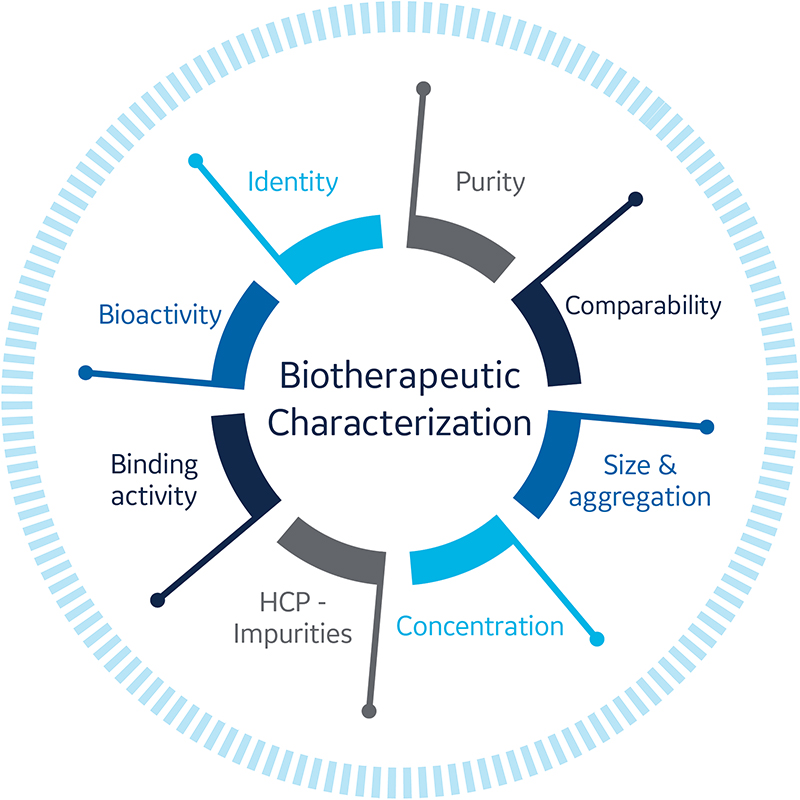Process effects on drug product quality in pharmaceutical manufacturing—a validated measurement process
Insights into processes and steps for validation of surface plasmon resonance (SPR) assays as an analytical tool to improve drug quality in drug development.
Pharmaceutical manufacturing is an industry laden with many challenges and risks due to the life-changing nature of its products—drugs that can affect millions of human lives. Manufacturers perform immensely complex research and testing daily, while facing economic challenges and regulatory requirements. This article covers the benefits of surface plasmon resonance in the drug development pipeline and describes a recent validation guide specifically for the implementation of SPR technology in regulated workflows.
Getting it right from the start in the drug development process
According to Fredrik Sundberg, Ph.D., Global director of strategic customer relations at Cytiva, Uppsala, Sweden, “the key to successfully launch a drug product on the market is to thoroughly understand, early in the drug development process:
- The mechanism of action of the drug candidate
- Molecular stability of the candidate during development and manufacturing
- The influence the process parameters will have on the product’s quality with respect to patient safety.”
Sundberg works closely with the biopharma industry to improve current workflows associated with discovery, development, and manufacturing quality control by providing various types of bio-analytical solutions support. According to him, understanding of the process is the key to success. “It’s essential in the design of the process itself, candidate selection, and recognizing the manufacturability and scalability of these candidates. Most of the impurities, such as DNA residue, host cell proteins (HCPs), additives, etc., can be minimized if you make the right decisions early on, and you can hone in on the best combination of biological activity, biophysical properties, sequence, and epitope diversity in the search and development of your leads.”
Proper process understanding allows researchers to critically identify factors that impact the drug substance and product and minimize or maintain them at approved levels. This way, researchers can achieve the desired therapeutic outcome without compromising patient safety or introducing dangerous side effects. It is also essential to demonstrate this understanding in submissions to the health authorities.
Monitoring critical process parameters for a well-characterized product
Both upstream processing and downstream processing can affect critical quality attributes of the drug molecule under development (Fig 1). These effects can result in process-related impurities (e.g., DNA residue, HCPs), product impurities (e.g., aggregates like dimers, oligomers), and post-translational modifications (e.g., glycosylation and conformational changes that can affect critical binding epitopes).
To establish a well-characterized biological product, many aspects of the drug substance and product must be monitored including:
- Charge and molecular weight distribution
- Primary/secondary/tertiary structures
- Mechanistic pathways
- Biological activity in terms of in vivo potency and binding affinity
Fig 1. Critical quality attributes in biotherapeutic characterization.
Robust information-rich tools for pharmaceutical analysis
Innovative protein analysis tools can provide more information faster and enable better comparability when the process is scaled up (think dimensions of chromatography columns, bioreactors, etc.). Advanced analytical approaches, such as liquid chromatography-mass spectrometry (LC-MS)i, and novel electrophoretic techniques like 2D Differential-in-Blot Electrophoresis (2D DIBE)ii are now increasingly used to characterize HCPs and monitor impurities.
Benefits of SPR technology and its role in the biopharma industry
SPR technology can be used to study molecular interactions in real-time with label-free detection. The major advantage of the technology is that it provides a wealth of information related to affinity, kinetics, concentration, thermodynamics, bio-similarity, specificity, and selectivity.
SPR is a powerful tool for understanding structure-function relationships and can be used from early basic research all the way through to development and manufacturing as a platform technology in the biopharma industry.
Some of the key benefits of SPR are:
- Efficiency: Shortens the time to market with faster access to information, allowing researchers to understand the process faster and make corrections readily at the beginning.
- Real-time detection: Comparing SPR to traditional immunoassays such as ELISA, it’s apparent that the reproducibility, precision, and speed is improved due to automated, real-time detection. The directness of the assay makes it efficient and easy—no labels or radioisotopes to do the read-out; binding and active concentration can be read directly instead.
- Kinetics: SPR provides detailed information on the kinetics of the binding—that is a unique feature in the technology. Structure can affect binding, which determines function. SPR monitors the effects of structural changes (conformational changes, glycosylation, aggregation, etc.) on critical binding epitopes by measuring binding activity (affinity, kinetics) and active concentration.
- Precision: It’s a very precise assay, usually within 5% coefficient of variation (CV), which is much better than typical cell-based assays, where the variation is often 30% or more. With a highly variable assay in place for lot release, it’s difficult to detect subtle changes in drug structure and function over time. There is a risk of not catching sub-potent batches in time, which can result in time-consuming, out-of-specification investigations; failed batches being scrapped and, in the worst case, a batch recall.
- Other novel features: Biacore SPR systems provide novel features such as sensorgram comparison—a novel methodology that facilitates the study of complex interactions (such as binding of monoclonal antibodies to Fc receptors).iii The method compares entire binding curves and generates a similarity score to measure the similarities in binding profiles. Unlike other analytical techniques, sensorgram comparison provides a holistic way of assessing target binding for the most complex biologics (Fig 2).
“In manufacturing, using sensorgram comparison provides a rapid ID of the drug-target interaction, and the overall SPR analysis provides more information faster, finishing an assay in ten minutes versus several hours,” says Sundberg. “With SPR technologies, you can detect subtle changes very early on and take corrective action in due time to mitigate potential issues.”
A

B

Fig 2. (A). The sensorgram provides real-time information about binding profiles with binding responses measured in resonance units (RU). Association: interactions in solution bind to molecules on sensor chip surface. Dissociation: Binders allowed to dissociate from molecule on sensor chip surface. (B). Comparison window is within the two blue lines; signals between the upper and lower limits are regarded as similar.
Common barriers to adopting SPR technology
There are four main issues when it comes to adopting a newer technology such as SPR.
- Lack of awareness: Some still believe SPR systems are only for research and discovery. They may not be aware of the regulatory recognition the technology has received from the FDA and other agencies. They don't know it can be used in all stages of the development process.
- Resistance to change: The mentality of sticking to traditional, conventional methods because they are familiar and have worked for so long, can set researchers back by years. The same studies could be done with higher precision and faster, using newer technology.
- Cost/effort/resources needed to change the established system, instrumentation, and standard operating procedures (SOPs) for a new technology: Switching to a new technology requires extra resources and time. Not only is it a financial commitment, but it’s a commitment to investigating the new skills/time required to develop, set up, and validate a new assay. That includes writing and establishing several SOPs and, in certain situations, cross-checking the new technology against existing methods to ensure results match in terms of potency, concentration, binding profiles, etc.
- Understanding the validation process: The biggest question most scientists have is, “How do I validate an SPR assay?” According to Sundberg, this is one of the main hurdles for wider adoption within the industry today.
SPR assay validation guideline
A new SPR validation guideline has been developed by an industry working group to provide a recommended pathway for implementation of SPR technology in regulatory workflows. Sundberg, a corresponding author on the guideline, notes it is a technical best-practice recommendation based on the FDA, USP and ICH guidelines, but adapted to fit SPR technology. It describes practical points to consider for validation of potency assays, kinetic rate constants, and affinity assays. “We collected the best practices from industry researchers who have successfully conducted and validated SPR assays,” Sundberg says. “A validation document like this enables both the analyst and the regulator to use a standardized approach to SPR applications in GMP.”
The validation guideline details five key steps to validation of SPR assays. In brief, these are:
- Instrument qualification: The baseline requirement is installation, operational, and performance qualification (IQ/OQ/PQ). Systems should be qualified in their actual operating environments, and users need to secure the life of analytical data (access, data integrity, etc.). At this point, understanding ER/ES Part 11 compliance for electronic records and signatures, the record-keeping requirements, and compliance aspects is of fundamental importance.
- Reagent qualification: The next step is selecting the right reagents and ensuring their quality. Results will depend on what is added to the assay. If antibodies were bought from a third-party supplier, their stipulated activity must be checked and verified.
- Assay development: At this step, researchers need to give substantial time and attention to assay development and formulate and set the acceptance ranges for the respective validation method. This is where the framework for the validation itself is set up. Thus, it’s necessary to run an adequate number of experiments to select a good system suitability test, as well as to understand the validation in terms of precision, accuracy, range, etc.iv,v
- Validation: This is merely execution. Quality control tests should be run on three validation batches (or more) and pass. It’s important to note that validation is not a single event; it's a life cycle approach that starts with IQ/OQ/PQ and ends with system retirement.
- SOPs: Operating procedures need to be in place for every step of the life cycle (e.g., methods, data management, tech transfer, maintenance, and retiring systems).
Analysts can access the best practices in the industry using the guideline, mapping out a starting point for validation and develop the approach in a step-by-step, structured manner that can accelerate the process timeline. Furthermore, regulators and quality assurance teams can follow the guideline to understand what to expect from a validated SPR assay and what to focus on during inspections. “This type of approach is a game-changer for the SPR community and a win-win situation for the global industry and regulators,” adds Christina Burtsoff Asp, Global marketing manager at Cytiva, Uppsala.
Conclusion
With health authorities continuing to approve commercial assays that use SPR, and the introduction of the SPR Assay Validation Guideline, the industry will see more standardized approaches for qualification and validation that will drive an increased uptake in GxP applications. Additionally, there will be more novel analytical approaches for comparability (such as sensorgram comparison), with an opportunity to further innovate quality control strategies.
i Lee, H. et al. Identification and control of impurities for drug substance development using LC/MS and GC/MS, J. Liq. Chromatogr. Relat. Technol., 31, 2235–2252 (2008).
ii Sayeed, M. et al. Enhanced HCP coverage analysis utilizing multiplexed 2D electrophoresis.
iv ICH Harmonized Tripartite Guideline Validation of Analytical Procedures: Text and Methodology Q2 (R1), Step 4 version (1994).
v ICH Harmonized Tripartite Guideline Validation of Analytical Procedures: Text and Methodology Q2 (R1), Step 5 version (1995).

